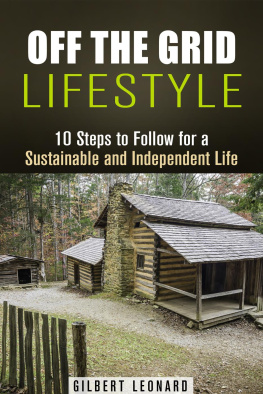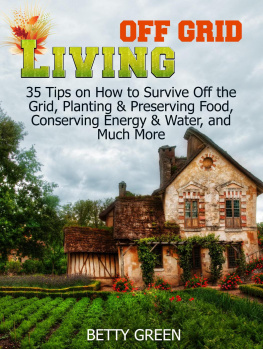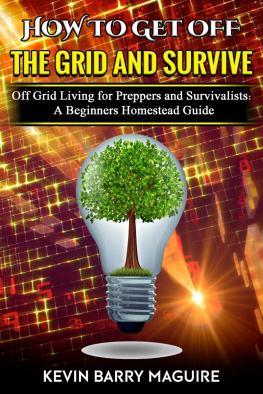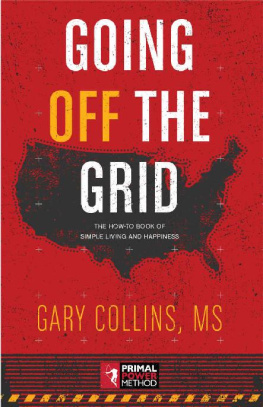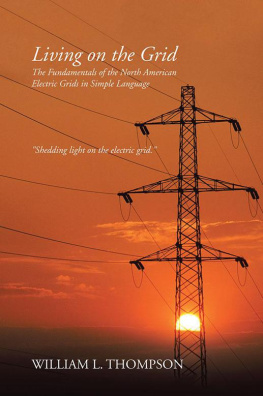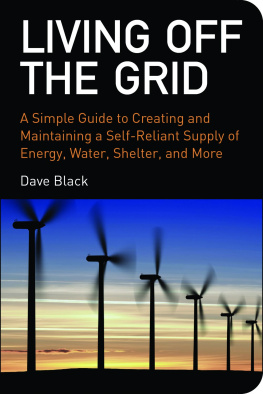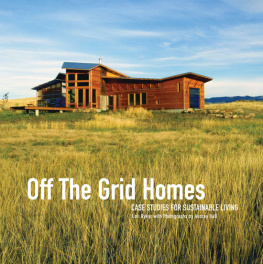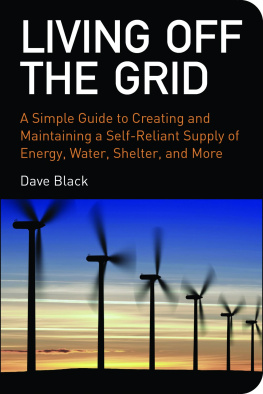Off the Grid Lifestyle
10 Steps to Follow for a Sustainable and Independent Life
Copyright Notice
Reproduction, duplication, transmission of this document in part or in whole is permitted only with written permission from the publisher. All rights reserved.
Respective brands and trademarks mentioned in this book belong to their respective owners.
Disclaimer
This document is geared towards providing summarization of information related to the topic. While all attempts have been made to verify the accuracy of the information, the author does not assume any responsibility for errors, omissions, or interpretations of the content. The information is offered for informational or entertainment purposes only. If professional advice is necessary, a qualified legal, medical, financial or another respective professional should be consulted. The reader is responsible for his or her own actions. The publisher does not accept any responsibility or liability arising from damages or losses, real or perceived, direct or indirect, resulting from the use of this information.
Table of Contents
Introduction
I magine being able to live solely off the land, relying on nothing but your own hard work. Its a life completely free from debt, consumerism, and resource consumptionthe ability to live a sustainable, ecologically friendly life. Does it sound impossible? Not anymore!
Recent technological advancements and an overwhelming wealth of information have made it easier than ever before to live off the grid , in a sustainable and independent lifestyle. Nowadays, you need not sacrifice comfort or security to life off the grid; in fact, theres very little reason anyone should rely so completely on an already overburdened infrastructure.
People decide to live off the grid for many different, and equally valid, reasons. Resource consumption is one of the best reasons to live off the grid. Living sustainably means taking full advantage of the renewable resources at your disposal; no longer depending on expensive and polluting fossil fuels, an off the grid home can utilize the free and limitless power of the wind, sun, or water to power homes and electric devices. Salesman often says these power stations pay for themselves, and its completely true. After initial set-up costs, the power you get every day is without cost to you.
That financial freedom is another big reason to consider a life off the grid. You no longer have to pay the same monthly bills you do at a regular home. With no gas bills, no electric bills, and no water bills, youre free to invest your money elsewhere. Its a truly independent life!
For those who deem an off the grid lifestyle a valid choice, youll notice varying levels of commitment. Dont feel as though living off the grid requires a countryside lot, a hand-built house, and a solar farm. This book is designed to benefit people of all commitment levels. Whether building and powering a house from scratch is your goal or you simply want to turn your typical suburban home into something more eco-friendly and sustainable, we have answers and tips on getting started!
There are many factors to consider when preparing to live a life off the grid. You may peruse this book at your leisure; chapters are largely independent of one another, so reading the sections you find most applicable to your case is perfectly all right. However, we urge you to read this book in its totalityyou may find a life completely free of obligations to modern society is more easily attainable than you think.
Chapter One: Building Financial and Infrastructural Independence
I n this chapter, you will learn:
- How living off the grid is more than just avoiding bills
- Considerations in changing your lifestyle
The Many Grids
W e often see the phrase the grid and take it to mean everythingnot just the electrical grid, but everything else which causes dependence on the greater infrastructure of your local or federal government, or the companies in your area.
The truth is that there are many grids. Its up to you to choose which grids to live independent of. Living completely on your own is valid but very difficult choice, and not one covered in this book. Instead, this book focuses on investing in your sustainable lifestyle . Yes, you can build your own waterwheel by hand, and then build an electric generator using scrap metal, and then use discarded wires to wire up the log cabin you hewed from the lumber of your land. But instead, well examine some of the new technologies at your disposal to make living off the grid much easier.
When living on your own, you must consider management of power, water, and waste, transportation, and food distributionall of which have their own corresponding grid in civilization.
The Cost of Reliance
H ave a look at your next monthly bills and consider how much money youre flushing down the drain. In 2013, the average American spends $110 per month of power consumption alone on a staggering 900kWh. Water bills can vary depending on climate though California serves as a stark reminder of the dangers (and financial cost) of over consuming water. Mortgages, HOAs, trash disposal, and sewage just add to the list of bills you have to pay as a suburbanite.
And the cost isnt just hitting your wallet. Every day, the typical person consumes 80 to 100 gallons of water and one gallon of gasoline while also producing nearly four and a half pounds of trash. Americans consume more resources than any other country on Earth. For some idea of exactly how greedy most Americans are, we can look at the ecological footprint data made available by WorldWatch.org. According to their most recent data, the world has 1.9 hectares (.0073mi2) of productive land available per personthis land must be capable of both producing resources and absorbing waste.
However, the average person currently uses 2.3 hectares, with Americans taking the lead by taking up nearly 9.7 hectares of usable land each. All this despite the existence on less than .5 hectares of land being more than adequate. As you can see, Americans are responsible for taking a much larger piece of the pie than others.
Help Yourself to Help Others
T aking even the simplest steps to living off the gridtaking advantage of the renewable and sustainable options at your disposalwill help ease the burden on the planet and your wallet. An off the grid lifestyle is all about utilizing resources to their most efficient ends, conservation, and recycling. The fact that this lifestyle will also save you money, in the long run, is only a bonusfor some, its perhaps the primary driving factor, but you can be happy to know your willingness to save money or insulate yourself from threats to the national grids will also be helping to save the planet, too.
Chapter Two: Factors of Sustainable Living
I n this chapter, you will learn:
- Which resources you should watch during the year
- Dangers of an isolated home
- Laws and costs of living off the grid
Analyze Your Consumption
T he first steps you should take before even considering an off the grid lifestyle is to analyze your daily, monthly, and yearly consumption of resources. You should discover which resources youre able to cut off, and which you might not be able to live without.
The easiest resource to consider is power. Electricity is easier than ever to produce on your own, with different options depending on climate and location. The solar industry, for example, grew by an amazing 34% from 2013 to 2014, thanks to solar panels becoming cheaper, more reliable, and more efficient. In the resources guide of this book, we have included NRDCs renewable energy map , which describes the most efficient renewable resource in your area.
Next page
